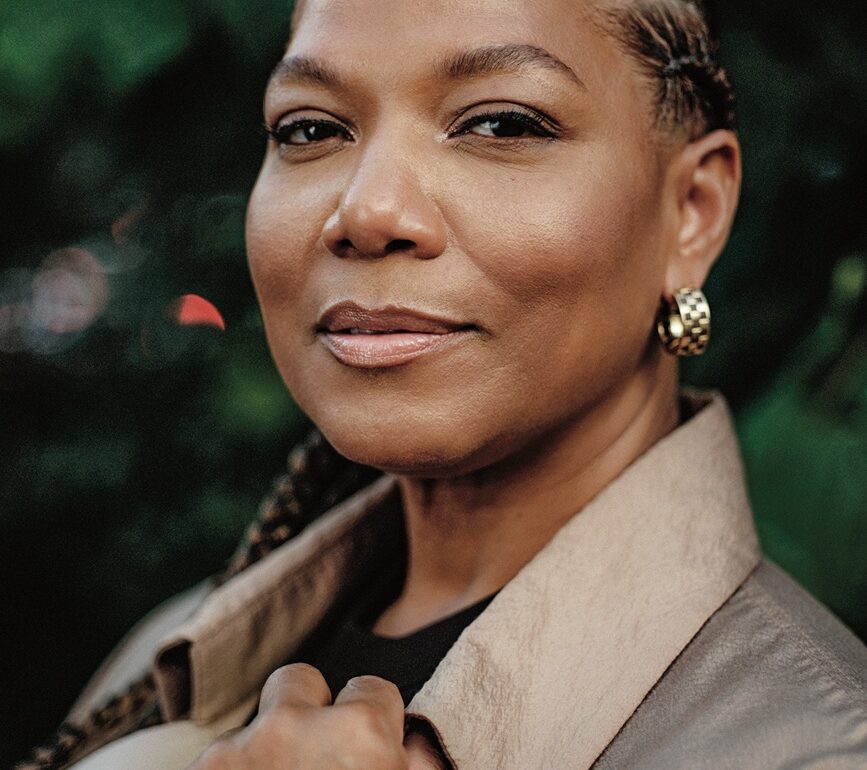
Dana Owens was just 15 when she and her friends started “going over”, as they called it, from Newark, New Jersey, to the Latin Quarter, a nightclub in Midtown Manhattan. She’d finish her shift at Burger King, change into her Swatch tracksuit and take the commuter train under the Hudson River and the subway up to Times Square, where a bouncer would pat her down for weapons. Once inside, she recalls, “it’s tight and it’s hectic and the energy is crazy”. Up on the stage were M.C.s like Melle Mel and Big Daddy Kane — artists she’d dreamed about seeing live — whose faces she knew from posters or album covers (rap videos were still rare in 1985). There, where culture was being made in real time, DJs tested out records on the crowd before playing them on the radio, and Owens picked up moves that nobody at Irvington High School knew until she brought them back across the river.
The sensitive, magnetic kid who would come to be known as Queen Latifah was a quick study. As a teenager, she wrote poetry inspired by the Black Arts Movement writer Nikki Giovanni, read science fiction novels by Octavia E Butler and played basketball on a team that won two state championships. She grew up with house music, show tunes, reggae, jazz and gospel. But the Latin Quarter (or Quarters, as it was commonly referred to) was the crucible of a whole new sound, a place where M.C.s delivered praise songs, usually about their own prowess, scored by ingenious soul samples and abrasive effects. There were sets by hot female acts like Salt-N-Pepa (whose 1986 track “My Mic Sounds Nice” was, Latifah says, “a banger”) and DJ Jazzy Joyce (who wore sweatpants and sneakers like she did). Among the most galvanising was MC Lyte, a virtuoso performer from Brooklyn even younger than her. Latifah remembers thinking, “If Lyte can do it. . . .” Hip-hop was driven by confident, competitive young people who watched one another excel and thought, “Why not me?” They thrived on rap and dance battles and actual fights. “But in the midst of all this chaos,” Latifah says, “was the hottest music you ever saw in your life.” She smiles, adding, “But I was not supposed to be in this club.”
Such illicit crossings have defined Latifah’s professional life, as has her refusal to land on any one thing — a quality that, I discover on a recent afternoon, also characterises her storytelling. We’re sitting in a dimly lit room at the Hit Factory, New York City, a recording studio in NoHo about 40 blocks south of where the Latin Quarter used to be (after closing in 1989, it was replaced by a hotel), and she wants me to picture the scene in its complexity: intensely creative and rightly forbidden. The same 360-degree view is required to understand Latifah herself. She’s often celebrated for her pioneering achievements in hip-hop: She’s the first solo female rapper to have a gold album; as we go to print, she’s due to become the first woman rapper to receive a Kennedy Center Honor for a lifetime contribution to culture. (She’s also the first hip-hop artist to land a star on the Hollywood Walk of Fame.) But in addition to her four rap albums, Latifah, now 53, has released two jazz albums; hosted two daytime talk shows; and appeared in more than 60 films, many of which she developed with her management and production company, Flavor Unit Entertainment, founded in 1995 with her business partner, Shakim Compere. By 2003, she was as famous for her high-cheek-boned face in cinematic close-up as for her voice, becoming one of CoverGirl’s first full-figured Black models, and later creating her own cosmetics line with the brand geared toward women of colour. As the star of the spy thriller “The Equalizer”, now approaching its fourth season on CBS, she became one of the first Black female leads on an hourlong network drama.
A 5-foot-10 Black woman from New Jersey only launches and sustains a career like hers with an implacable sense of self-belief. But her power moves — and her confidence — have also been fostered by tight groups of collaborators. We might call them her “posses”, a concept of rap kinship she advanced on her 1989 single “Princess of the Posse”, then translated into several projects that now represent various phases of her cultural influence. Older hip-hop heads still champion Black feminist anthems such as “Ladies First” (1989), which she recorded with the British rapper Monie Love, and her Grammy-winning track “U.N.I.T.Y.” (1993) with its sonic left hook: “Who you callin’ a bitch?” Slightly younger fans met her on “Living Single”, a sitcom featuring four Black girlfriends in Brooklyn that aired from 1993 to 1998. Her turn as a lesbian bank robber in F Gary Gray’s outlaw girl-group film “Set It Off” (1996) is now a classic of the genre; and the 2017 comedy in which she co-starred, “Girls Trip”, became the first movie with a Black woman screenwriter (Tracy Oliver, co-writing with Kenya Barris) to gross over $US100 million ($AU156 million) at the box office.
These days, Latifah’s wholesome, general-audience appeal can conceal the force of her impact. But she strategically facilitated several mergers that once seemed highly unlikely and now define our era: between rap and Hollywood, hip-hop and high fashion, Black capitalism and activism. We now take for granted that Ice Cube and Common produce and star in films and TV shows, and that several of rap’s most innovative artists are women (Megan Thee Stallion, Latto). We increasingly see Black actresses onscreen (Viola Davis, Zendaya) representing queer love and desire, and find cover-girl aesthetics embodied by curvy Black artists and models in Rihanna’s Savage X Fenty fashion line. We see this because we are living in a world that Latifah helped make. If she seems like us, it’s largely because she has made us like her — members of a posse she might want to roll with.
This is a short extract from our newest issue.
To read the full story, pick up a copy of our new issue in newsagents nationally or buy to receive T Australia straight to your letterbox. You will find it on Page 64 of Issue #16, titled “Queen Latifah”.
This post was originally published on this site be sure to check out more of their content.









